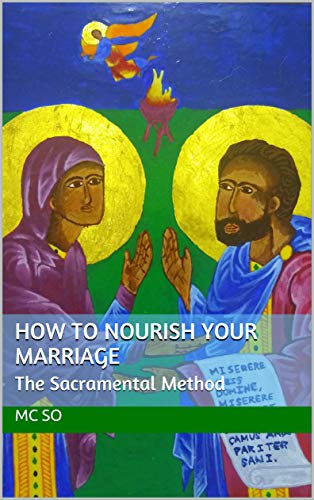To help restore marriage as a vocation among Catholics, How to Nourish Your Marriage: The Sacramental Method briefly explains how marriage benefits from the seven sacraments that Christ instituted as the essentials for every human life. Two chapters introduce the book and the sacraments as a whole. The next chapters treat, in order, “Matrimony,” “Baptism,” “Confirmation,” the “Anointing of the Sick,” “Holy Orders,” “Penance and Reconciliation,” and the “Eucharist.”
Subscribe to our Newsletter & Get Weekly Catholic Books for as little as $1
Perhaps because Michael So studied as a seminarian before marrying, he almost seems to be writing homilies. Each chapter starts with Scripture, incorporates anecdotes, and explicates Church teaching, often with excellent references to the Catechism of the Catholic Church. One can imagine a friendly, upbeat priest preaching such words to a congregation. The powerful discussion questions at the end of each chapter would enhance an Examination of Conscience. How to Nourish Your Marriage: The Sacramental Method would interest engaged or married Catholics, whether individually or as couples, who are seeking light tips in just 43 pages.
So grounds his definition of the sacraments in several excerpts of the Catechism, summarizing the sacraments as “works of God that transform open and faithful recipients to be like Jesus” (6). He explains that the sacraments elevate natural elements of life into supernatural ones (7). Thus sanctified, humans who keep receiving the sacraments can join the family of God as His adopted sons and daughters for eternity (7).
Launching from this solid overview of the sacraments, several of the chapters present compelling ideas. “Matrimony” likens the covenant between God and humanity to the covenant between husband and wife. Even as someone familiar with this parallel, I found fresh angles, especially with regard to Biblical history, the difference between heaven and hell, and the distinctively marital fruitfulness of not only creating but also raising children. “Baptism” calls for marital unity with a whimsical analogy involving trees. Attending to the nuances of why spouses might hold grudges against each other, “Penance and Reconciliation” supplies practical advice on forgiveness. “Eucharist” makes a touching comparison: “Every time the Eucharist is celebrated, the participants of the Mass are brought to the foot of Jesus’ Cross. Just so, every time a couple chooses to love each other, their matrimonial vows are in a sense made present and renewed” (38). So adds that “the Eucharist makes us into one flesh with God and with each other,” a family that lasts forever, just as every marriage should continue until the death of one of the spouses instead of ending in divorce (38–39). The final chapter, “Concluding Thoughts,” gives a moving exhortation from So’s heart.
As the book assumes basic knowledge of each of the sacraments, it caters to Catholics specifically. How to Nourish Your Marriage offers many sweet lessons to believers on the path to matrimony.
Subscribe to our Newsletter & Get Weekly Catholic Books for as little as $1
Join Here for FREE to Never Miss a Deal
Find new favorites & Support Catholic Authors



